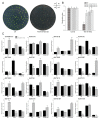The Landscape of Autophagy-Related (ATG) Genes and Functional Characterization of TaVAMP727 to Autophagy in Wheat
- PMID: 35055085
- PMCID: PMC8776105
- DOI: 10.3390/ijms23020891
The Landscape of Autophagy-Related (ATG) Genes and Functional Characterization of TaVAMP727 to Autophagy in Wheat
Abstract
Autophagy is an indispensable biological process and plays crucial roles in plant growth and plant responses to both biotic and abiotic stresses. This study systematically identified autophagy-related proteins (ATGs) in wheat and its diploid and tetraploid progenitors and investigated their genomic organization, structure characteristics, expression patterns, genetic variation, and regulation network. We identified a total of 77, 51, 29, and 30 ATGs in wheat, wild emmer, T. urartu and A. tauschii, respectively, and grouped them into 19 subfamilies. We found that these autophagy-related genes (ATGs) suffered various degrees of selection during the wheat's domestication and breeding processes. The genetic variations in the promoter region of Ta2A_ATG8a were associated with differences in seed size, which might be artificially selected for during the domestication process of tetraploid wheat. Overexpression of TaVAMP727 improved the cold, drought, and salt stresses resistance of the transgenic Arabidopsis and wheat. It also promoted wheat heading by regulating the expression of most ATGs. Our findings demonstrate how ATGs regulate wheat plant development and improve abiotic stress resistance. The results presented here provide the basis for wheat breeding programs for selecting varieties of higher yield which are capable of growing in colder, drier, and saltier areas.
Keywords: TaVAMP727; Triticeae species; abiotic stress; autophagic homeostasis; evolution; seed size.
Conflict of interest statement
The authors declare no conflict of interest.
Figures








References
-
- Floyd B.E., Pu Y., Soto-Burgos J., Bassham D.C. To Live or Die: Autophagy in Plants. In: Gunawardena A.N., McCabe P.F., editors. Plant Programmed Cell Death. Springer International Publishing; Berlin, Germany: 2015. pp. 269–300.
MeSH terms
Substances
Grants and funding
LinkOut - more resources
Full Text Sources

